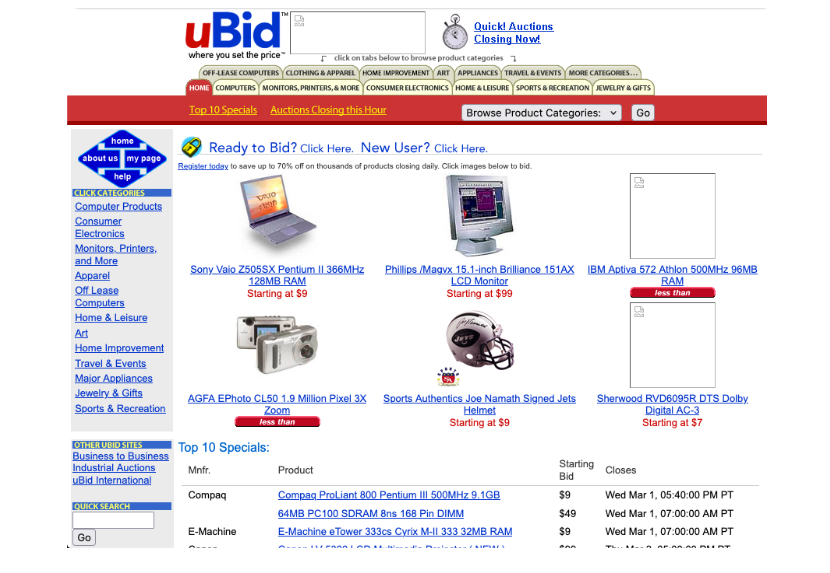Introduction
Online marketplaces such as Amazon, Etsy, and uBid have reshaped the way global commerce works, but their success stories are often paved with reinvention and failure. uBid.com, once a pioneering force in digital auctions, offers a compelling lens to examine the shifting tides of e-commerce. uBid was caught up in the e-commerce market’s shifting landscape and managed to adapt, but it eventually shut down in 2022. This article will explore uBid’s evolution, from Gregory K. Jones’ observations and insights, to find key lessons and predictions for the future of online marketplaces.
Lessons From uBid.com’s Evolution
Like many websites in the dot-com era, uBid was an active and thriving website. It launched in 1997 and went public just one year later. It kept pace with and adapted to the ever-changing e-commerce market, but its success didn’t last. uBid.com shut down in 2022, though its parent company lives on. uBid’s history shows just how important adaptability, user trust, marketplace design and experience, and diversification and niche focus are.
Adaptability is Everything
Just as in other competitive and rapidly changing industries, adaptability is crucial for surviving in the e-commerce market. One example of adaptability is adjusting value propositions. A value proposition is a declaration of intent that outlines what a company provides its customers. Value propositions explain how a product fills a need, why it is necessary, and why it’s better than similar products.
Value propositions need to change over time for a company to remain competitive. Customer tastes change, and for a business to remain competitive, it needs to reevaluate its value proposition when needed.
The Importance of User Trust
Users who trust a company are likely to continue using its products and services. In order to build and maintain user trust, companies must be adaptable and deal with problems both immediately and ahead of time.
Trust, transparency, and security are core drivers of retention. Companies boost customer trust when they are transparent about the challenges they face, how they deal with challenges, and how they operate. Security also drives trust because customers trust companies that have safeguards in place are safe and secure.
Marketplace Design and Experience
Customers highly value good marketplace design. They want an easy-to-navigate website and an intuitive shopping experience, and a well-designed e-commerce website encourages customers to buy more products. uBid’s user interface evolved to become more intuitive and pleasing—in 2000, uBid’s website was basic and utilitarian, but by 2020, it had evolved into an intuitive, visually pleasing website.


Diversification and Niche Focus
Diversification and niche focus are instrumental to success in the e-commerce industry, and failing to pivot into new categories or strengthen a niche can be fatal for an e-commerce business. uBid changed hands multiple times, and it went through multiple rebrandings in order to stay relevant and hold onto its niche. Unfortunately, uBid was unable to hold on to its auction site niche, and in 2020, it rebranded as a restaurant and entertainment digital coupon company.
The Current State of Online Marketplaces
Today, the e-commerce space has stabilized, and there are a handful of big platforms along with more niche ones. Amazon, Etsy, and eBay are some of the biggest players out there, but there are also marketplaces such as Depop and StockX. Depop is a clothes marketplace, and StockX mainly sells sneakers and a small collection of clothes.
Trends that shape the e-commerce landscape include mobile-first shopping, social commerce and influencer integration, AI-powered personalization, and sustainability and ethical sourcing.
Various E-commerce models are also another current e-commerce feature. There are two models that e-commerce companies follow: marketplace vs. Direct-to-Consumer models. Companies that use the marketplace model sell their goods on marketplaces like Amazon and eBay. Selling on marketplaces means that e-commerce companies can tap into a built-in following and don’t have to build their own. The direct-to-consumer model means that companies sell their product on their websites and avoid listing their items on other sites. While the direct-to-consumer model has no built-in customer base, it gives companies complete control over their brand, better profit margins, and a more personalized experience that boosts customer loyalty.
Insights for Emerging Marketplaces
In today’s e-commerce landscape, online marketplaces have a hard time getting started and standing out from their competitors. They need to constantly evolve, learn from their competitors, and plan for long-term success and adaptability.
The Strategic Need to Evolve
To keep up with and stand out from their competitors, emerging online marketplaces need to conduct constant market research and create customer feedback loops. They need to find niches, discover trends, and find ways to keep their customers coming back.
Learning from Legacy Platforms
Emerging online marketplaces need to avoid stagnation. They can do this by following trends and innovating beyond their product: they can branch out into logistics, services, and content creation.
Building for Long-Term Relevance
Building for long-term relevance is one of the most important strategies for a new online marketplace company. They need to think about the future and what direction their business will take. Investing in adaptability and not just scale will help accomplish this, as adaptability is more important than company growth. Focusing on adaptability may sacrifice short-term profitability, but it will keep online marketplaces profitable over a longer period of time.
What the Future Holds
E-commerce’s future is not entirely clear, but trends indicate where it’s heading. There are some clear hints about what the future holds: consumer trust will be critical, there will be hybrid commerce models, tech will be increasingly integrated in online marketplaces, hyper-personalization will be increasingly common, and community-driven commerce will make a big splash.
Trust and Transparency Will Be Non-Negotiable
Customers will increasingly demand to work with verified sellers, use buyer protection policies, and have an open rating system that tells them what real people think about products and services.
Hybrid Commerce Models
Hybrid commerce models combine auction, fixed-price, subscription, and rental services. This will allow companies to reach more customers and provide a comprehensive range of services.
Tech Integration
E-marketplace companies are integrating advanced technology in their shopping experience. AI, blockchain for authentication, and immersive shopping (AR/VR) are some examples of this technology.
Hyper-Personalization
Data-driven experiences tailored to individual buyer profiles are increasingly common in e-commerce. Online marketplaces can track what customers buy, their internet browsing history, and other personal data to create a profile for them. The companies then use this profile to recommend products and services that customers may need or want.
Community-Driven Commerce
Social media is community-driven commerce’s main source. Community-driven commerce includes entertaining and engaging content, usually found on social media, that features brands and products. It also fosters a sense of community: when influencers use products in their videos, their followers may be more inclined to use the same products.
Conclusion
uBid.com’s trajectory offers critical takeaways—adaptability, trust, and innovation must be central to any marketplace’s evolution. uBid was able to pivot and rebrand multiple times, and that kept the site alive for many years. However, it eventually fell behind its competitors and was forgotten; it failed to continue adapting, innovating, and distinguishing itself from its competition. uBid demonstrates that as digital commerce continues to evolve, platforms that stay human-centered, agile, and future-focused will thrive in tomorrow’s marketplace economy.
 BACK TO BLOG
BACK TO BLOG
